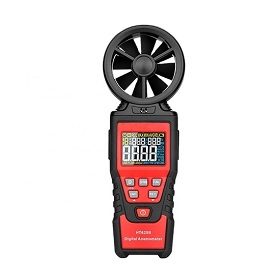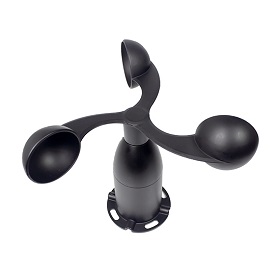Vane Anemometer vs. Cup Anemometer
An anemometer is a device used to measure and determine the speed or velocity of the wind. It is a common instrument in meteorology, as well as in various applications such as weather monitoring, aviation, environmental science, and engineering. There are several types of anemometers, each with its own way of measuring wind speed. But we will only discuss two of them here: the vane anemometer and the cup anemometer. Understanding the difference between a vane anemometer and a cup anemometer can choose the right wind speed measurement device.
Different Operating Principle
The key component of a vane anemometer is a set of small blades or vanes mounted on a spindle. These blades are usually made of lightweight materials such as plastic or metal. The spindle to which the vanes are attached is connected to a set of gears and an indicator or transducer. As the vanes rotate, they transfer this rotational motion through the mechanical linkage to the indicator. The indicator can take various forms, such as a dial, a digital display, or an analog output. It shows the wind speed by measuring the rotation of the vanes. The greater the wind speed, the faster the vanes rotate.
The cup anemometer consists of three parabolic conical cups fixed at 120° to each other on a support, the concave surfaces of the cups being orientated in one direction. The entire sensing section is mounted on a vertical rotating shaft around which the cups rotate at a speed proportional to the wind speed under the action of the wind. Mainly consists of three mutually 120° parabolic surface or semicircular cups form a plane wind instrument, according to the wind cups on the wind response to the rotation speed curve can measure the size of the wind speed.
Different Accuracy
It is generally accepted that vane anemometers measure wind speed more accurately and that their accuracy depends on the quality of the vane; the higher the quality of the vane, the higher the rotational speed, and the more precise the vane mechanism, resulting in more accurate wind speed measurements. Especially in turbulent or gust conditions, the vane responds quickly to changes in wind speed and direction. In addition, the measuring range of the vane anemometer is also very important, generally the measuring range of the vane anemometer is 0~45m/s, and the measuring range can also be adjusted according to the actual needs.
At present, the new cup anemometer uses three cups, and the performance of the conical cup is better than the hemispherical one when the wind speed increases the rotary cup can quickly increase the rotational speed to adapt to the air velocity, and when the wind speed decreases, due to the effect of inertia, the speed can not be immediately decreased, the rotary anemometer in the gust wind speed indication is generally high to become too high effect (resulting in an average error of about 10 percent), and therefore the response to sudden changes in the wind speed and direction may be a little poorer. and therefore may be slightly less responsive to sudden changes in wind speed and direction. However, they are still widely used and provide reliable measurements in many applications.
Different Application Scenarios
Vane anemometers are commonly used in weather stations to measure wind speed and direction. Meteorologists and climatologists use this data for weather forecasting, climate analysis, and research. They are essential tools for the wind energy industry, help assess the feasibility of wind turbine locations, monitor wind speeds at wind farms, and ensure the safety and efficiency of wind turbines. In aviation, vane anemometers are used for measuring wind speed and direction at airports and during flight. This data is critical for takeoff, landing, and navigating aircraft. Vane anemometers are employed on ships and boats to monitor wind conditions for safe navigation, especially for sailing vessels. They are also used in the offshore industry for operations such as oil rig positioning and marine construction.
The cup anemometer is also commonly used in weather stations, industrial environments, and for general wind speed measurements. In addition, it is used in aviation and aerospace applications to monitor meteorological conditions in aircraft, helicopters, rockets, and other vehicles to ensure safe flights, and in the maritime sector, where wind speed is critical to shipping navigation and maneuvering. Rotor anemometers are used by ports and maritime authorities to provide accurate wind speed information to assist in port operations and ship navigation. Cup Anemometers are easier to install and maintain than impeller anemometers and are commonly used in commercial and industrial applications.
Differences in Maintenance 
The vane anemometer is easy to use, just install it in the place where the wind speed needs to be measured, connect the power supply or battery, start the instrument, and then the wind speed can be measured automatically. Their high accuracy, stability, and intuitive readings make them ideal for mass production and use. However, it usually has more moving parts and may require more frequent maintenance and calibration due to wear and tear. The cup anemometers have fewer moving parts and are usually easier to maintain, making them suitable for long-term unattended operation.
Differences in Cost
Vane anemometers and cup anemometers vary in price, depending on several factors, including brand, model, accuracy, and performance. Vane anemometers typically have higher accuracy and performance, can measure a wider range of wind speeds, and are suitable for a wider range of applications. As a result, high-accuracy and performance impeller anemometers are usually more expensive. Different manufacturers and brands of anemometers may have different price levels. Some products from well-known brands may be more expensive as they usually come with more technical support and warranty. In addition, some anemometers may come with additional features and options such as data logging, communication interfaces, water resistance, etc., which may increase the price of the device. As a result, impeller anemometers are usually more expensive than rotor anemometers as they offer higher accuracy and performance for more application scenarios. However, prices can also be affected by market competition, sales regions, and other factors.
In summary, vane anemometers are preferred where accuracy and response time are important, such as in scientific research or wind energy applications. Rotor cup anemometers are usually used in less demanding applications where a good balance between cost, accuracy, and maintenance is desired, such as meteorological monitoring stations or industrial environments. The choice between the two depends on the specific requirements of the measurement task and budgetary constraints. Before purchasing, you can compare the prices and features of different products to find the right anemometer for your needs and budget. ATO automation can provide you with a selection of products.

